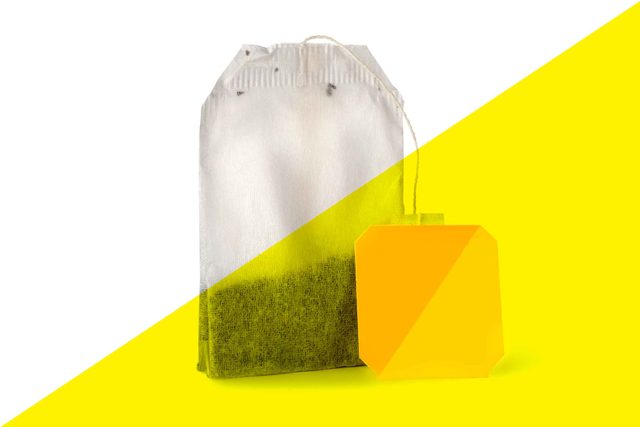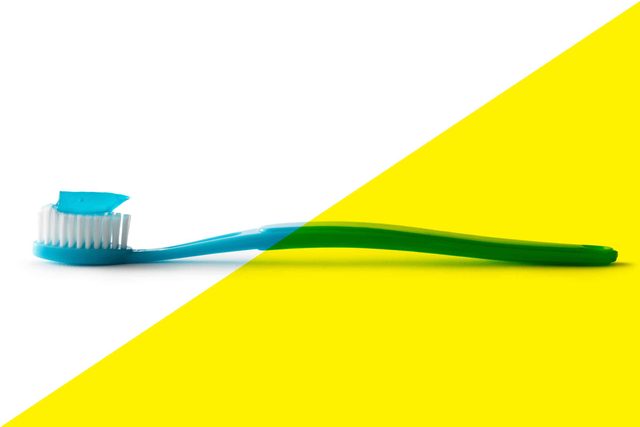
Repurpose your tea bags
Forget pricey ointments or prescriptions; the fastest way to get rid of cold sores (also called fever blisters) is already in your pantry. As natural remedies for fever blisters, tea bags contain tannic acid, a plant compound that gives your immune system a boost. To get the full benefits of this flavonoid, at the first twinge of a cold sore you should apply a damp, cooled black tea bag to the area where you expect the outbreak to occur, and keep the tea bag on for 10 minutes. Repeat three to four times a day to help reduce the duration and severity of a cold sore outbreak. Anecdotal evidence suggests that Earl Grey tea gets the job done best, possibly because it contains soothing bergamot oil as well as tannins. Here are more amazing health benefits of tea.

Eat more protein
Here’s another reason to eat your protein—it contains lysine, an amino acid that can be a lip blister treatment. Research has shown that foods rich in lysine (such as beans, yogurt, cheese, meat, fish, and milk) can act as a fever blister cure and can help shorten the length of a cold sore outbreak. To add more lysine to your diet, dine on fish for one night out of the week or make eggs a breakfast staple. Also, check these cold sore remedies you didn’t know you could make at home.

Zing fever blisters with zinc
Zinc oxide cream (a common ingredient in sunscreen) is no longer just a great addition to your next beach trip—it can also help heal fever blisters on your lips. In a 2001 study published in the journal Alternative Therapies, participants who applied zinc oxide cream to their fever blisters reported a faster healing time and a decrease in symptoms compared with those who applied a placebo cream. Plus, applying the cream at the first sign of tingling will protect your lips from the damaging sun, whose harsh rays can trigger a cold sore outbreak. However, zinc is known to negatively interact with certain antibiotics and drugs, so be sure to check with your doctor before applying. These are other weird ways the sun affects your body.

Rub on lemon balm
Pucker up! Lemon balm can cure a sore in a matter of days, research shows. The antiviral properties in this sweet-smelling ointment prevents your blisters from spreading, or worse, coming back a few days later. According to the University of Maryland Medical Center, subjects who applied lemon balm to their fever blisters saw a reduction in redness and swelling of their blisters after only two days. This lip blister treatment can be found at health food stores as well as online.

Store your toothbrush in a dry place
Because the cold sore virus is carried in saliva, one of the best ways to prevent fever blisters from happening is to take extra precaution with your dental hygiene. When you’re done brushing and flossing, keep your toothbrush on an open shelf where it’s exposed to circulating air or sunlight. A wet toothbrush in a moist bathroom is a prime hot spot for viruses to breed. And this gross reason is why you should never keep your toothbrush close to the toilet.

Cut out kissing
If you have a sore, say goodbye to smooching. The American Sexual Health Association estimates that more than 50 percent of the adult population is carrying the cold sore virus, and most of them will contract it from kissing people who have already have blisters. Since cold sores spread most easily in moist environments, giving a kiss anywhere (especially the mouth!) is not doing your lips—or your lover—any favors.

Apply ice
When all else fails, a little ice can go a long way. Cold temperatures can ease the cold sore’s swelling, reduce redness, remove crusting, promote healing, and ease pain. If you don’t have ice, a cool, damp cloth will do the trick, too. If you think you might have a canker sore instead, give these canker sore remedies a try. And, here’s how to figure out if your canker sore is actually something more serious.
